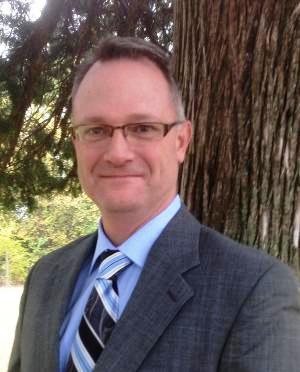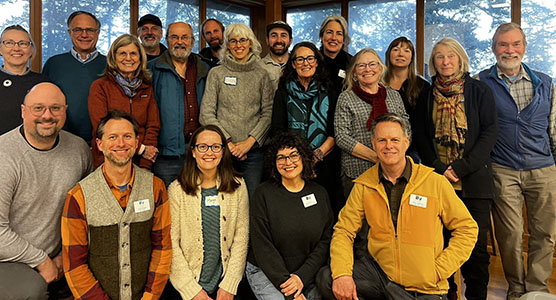Measures pass unanimously after vigorous discussion
— by Margie Doyle –
Eric Webb officially took the oath of office of Superintendent of the Orcas Island School District at its monthly meeting on July 24.
Webb reported to the Board on his three weeks on the job, which have been filled with “lots of meetings.”
He also reported on the construction project that began in late June and is currently working on excavation and rebuilding of the former School Library and OASIS classrooms, and lighting in the “old gym” in the center of the district campus. Come September, the library/OASIS building will house the Middle School classrooms.
Webb said that the work funded by the $460,000 energy grant (Link) is coming in under budget, and so some upgrades have been made possible.
Plans for providing food service beginning in January, 2015, when the current cafeteria/ Middle School building begins renovations are ongoing, Middle/High School Principal Kyle Freeman said. Discussions with Camp Orkila and Anacortes Food Service are part of those plans.
Superintendent Webb proposed a board retreat to take place in mid-October.
The OISD Board approved adoption of THE 2014-15 budget and authorizing a six-year capital projects levy for $500,000 per year (approximate mil rate of 23 cents/$1000) to be placed on the Nov. 4 election ballot.
Budget
The 2014-15 OISD budget is set at $8.7M with an enrollment projection, set in April by the Minimum Education Plan, of 750 FTE students: 361 in regular program; 382.5 in OASIS K-12; and 6.5 in Waldron School.
The Minimum Education Plan also called for a reduction of 4.9 Full-time Equivalent (FTE) teaching staff in the district: 4.02 in OASIS K-12; .88 FTE at Waldron School.
At Thursday’s meeting, OISD Board Member Tony Ghazel pointed out that the general budget increase is about six percent, from $8.1M in 2013-14 to $8.7M in 2014-15. Business Manager Keith Whitaker said that the overall budget increase is due to an increase in staff costs and addition of administration personnel last year.
Whitaker reported that the current fund balance has “dropped as expected” and at $250,000, is slightly below last year’s June balance.
Expenses during 2013-14 included:
- Salary increases to certificated, classified, and administrative staff
- Audits
- Superintendent search costs
- Class overloads and extra time
- Special Education Preschool bus route
“The good news is that the increases in revenue and expenditure were fairly even,” Whitaker said. “With adjustments made in the 2014-15 budget, we’re at a good place to produce more consistent and better results.”
The not-so-good news is that a total enrollment of 850 full time equivalent students would be needed to bring back all of the teachers, as well as to add a second full-day kindergarten teacher and other requested positions.
Whitaker reviewed the assumptions he made and method he used to calculate this number and concluded, “All costs would be covered, with a small surplus, with an enrollment of 852 FTE.”
The board reviewed the past year’s enrollment figures with a monthly average of 803 FTE. OISD Chair Scott Lancaster said that the current estimated enrollment is 795 FTE. Chris Sutton, participating by phone, noted that the past year saw 383 students in the “brick and mortar” Orcas-Waldron campuses; next year’s projections are for 362. “OASIS [K-12 alternative education program] is adding a lot more to bottom line than we think.”Kyle Freeman said, “OASIS has always grown; with the caution to have enough staff to keep the [student-teacher] ratio of 35 to 1; we’re looking for about 50 FTE. It sounds like we’ll have to open up OASIS even more to make this happen.”
The board consensus was that the growth and dependence of the OASIS program needs to be discussed at greater length, which they plan to do at the October Board retreat.
November Levy Vote
The board had a vigorous discussion before unanimously agreeing to propose a six-year, $500,000 per year levy to district voters in November. Ghazel and Lancaster balked at the six year total of $3M for the levy, but in the end, they concluded that the amount was necessary, with any expenditures to be monitored by the Board.
The total mill rate for the current M&O levy, tech levy, and bond is about $1.22. The proposed levy would increase that amount five to six cents for the next two years, before returning to the 2014 levels, Whitaker said.
“We have found ourselves over and over at a deficit for capital projects. In good conscience I think the district should carry a balance in capital projects for when unbudgeted circumstances come up. It would give us flexibility to make practical and cost effective choices about the facilities, and we can always carry it forward for technology. But if you don’t have the balance in reserve, you won’t have money to pay for unexpected capital expenditures.
“I don’t recommend paring it down and reducing the capital fund to zero. With the [proposed six-year levy] for capital projects, it makes it a safer and more functional fund.”
Board member Janet Brownell advocated maintaining strong technolgy support for the district and moved to approve the levy request. Lancaster pointed out that $1M of the levy would sustain the current $200,000 annually for a tech levy alone.
Ghazel agreed, saying, “The public decides. As stewards of the public’s money, we need to make sure we fulfill our promises.”
**If you are reading theOrcasonian for free, thank your fellow islanders. If you would like to support theOrcasonian CLICK HERE to set your modestly-priced, voluntary subscription. Otherwise, no worries; we’re happy to share with you.**










Welcome Mr. Webb! Here’s hoping that you are able to lead OISD in the years to come and bring a positive direction to the District
On the Capital Levy – There needs to be a dramatic shift at the district in terms of maintenance as we improve our campus. The only way we can avoid what has happened to our campus to-date is to start making the upkeep of our capital facility a priority. There is no reason to continue to dump money into capital improvements if we are not also willing provide the money for staff and supplies to keep them up.
We do not want history repeating itself.